Presonus vs Focusrite – which brand of audio interfaces should you choose?
We’ve recorded with interfaces from both companies.
Let’s compare models from each to figure out which is better.
Overview: PreSonus vs Focusrite
PreSonus
PreSonus offers a range of audio interfaces.
Most notably, the AudioBox series and Studio series.
AudioBox Series
The AudioBox series features the AudioBox Go, USB 96, iOne, and iTwo models.
Studio Series
The Studio series includes the Studio 192, 24c, 26c, 68c, 1810c, and 1824c models.
The main difference between each of these interfaces is the number of I/O and a few structural changes.
Focusrite
Scarlett 3rd Gen Series
Focusrite Scarlett 3rd generation includes the Scarlett Solo, 2i2, 4i4, 8i6, 18i8, and 18i20.
Like Presonus, the main difference is the number of I/O. But sound quality and other features are about the same.
We’ll compare the two of the most popular entry-level PreSonus interfaces – the AudioBox 96 and the Studio 24c – to the Focusrite Scarlett 2i2.
After reading this article, you’ll have a better idea of which option to choose for your home studio.
Focusrite or PreSonus: Which is Better?
When comparing Focusrite and PreSonus, Focusrite offers better interfaces. Scarlett interfaces have an easy-to-use design, professional quality high headroom preamps, and additional features like Air Mode. PreSonus interfaces also have quality features, but we agree with people who say its design has room for improvement.
PreSonus
PreSonus AudioBox USB 96
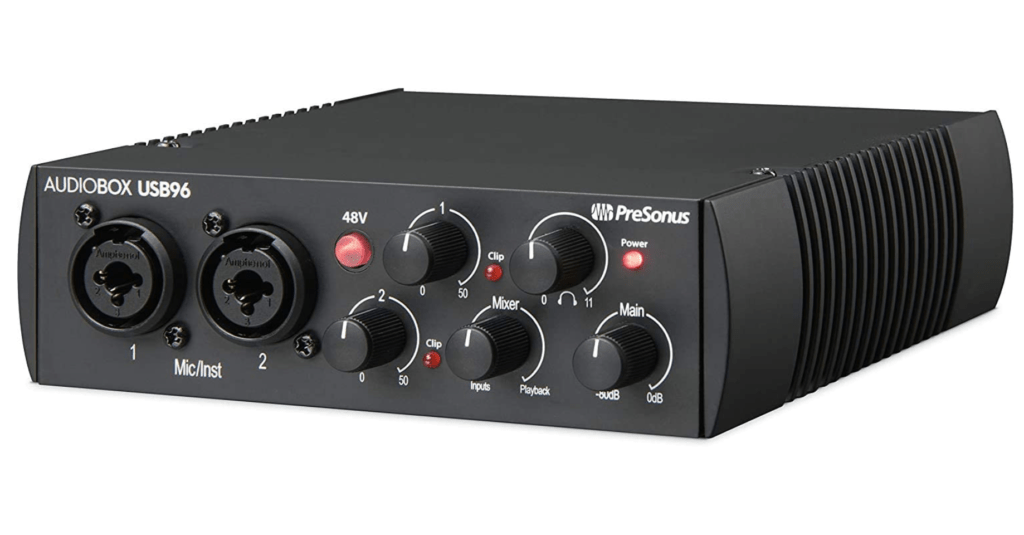
The Presonus AudioBox USB 96 is one of the most well-known interfaces under $100.
It’s durable, compact, and delivers great sound quality, especially for audio and music production.
You can’t go wrong with the USB 96 if you’re looking for an affordable recording solution for your home studio.
However, for streaming or podcasting with dynamic mics, you’ll find other budget interfaces with less preamp noise and more gain.
Overall, the USB 96 is ideal for looking to maximize sound quality on a tight budget.
Pros
Cons
- Housed in heavy-duty steel
- Lightweight / portable
- Direct monitoring for zero-latency recording
- No line-level inputs
- Small control knobs
- Not the best choice for dynamic mics
Features
- 2 combo inputs (XLR mic and ¼ inch instrument) | 2 balanced outputs | headphone output
- 2 Class-A mic preamps with up to 50 dB of gain
- LED indicators for clipping
- Mixer Control for direct monitoring
- +48V phantom power for powering condenser mics
- MIDI In & Out
- Software Bundle: Studio One Artist & Ableton Live Lite
- Resolution: 24-bit; 44.1 to 96 kHz
- Connectivity: USB-B
Design
The USB 96 has an outer metal structure to protect against damage.
Its compact and durable design makes it great for mobile recording.
However, since it’s so compact, the knobs on the front panel feel a little crammed.
Even so, this interface is still super easy to use. And its knobs turn smoothly.
Inputs and Preamps

The front panel includes two combo inputs – XLR inputs for mics and ¼-inch inputs for instruments.
Each input features a Class-A preamp and gain control – providing up to 50 dB of gain.
Next to each gain knob, you’ll find an LED indicator. You can use these LEDs to monitor clipping on each channel.
The AudioBox 96 also includes a +48V phantom power button for powering condenser mics. Along with a mixer control knob for direct monitoring.
Mixer Control Function and Volume Controls
With the mixer function, you can blend your direct signal with the signal from your DAW.
Using your direct signal lets you record with near-zero latency.
On the other hand, you can monitor through DAW and record with effects.
Conveniently, the AudioBox allows you to blend between the two.
On the USB 96, “inputs” represents your direct signal. And ”playback” represents the signal from your DAW.
Lastly, there are also separate volume knobs for headphones and the main output.
Back Panel
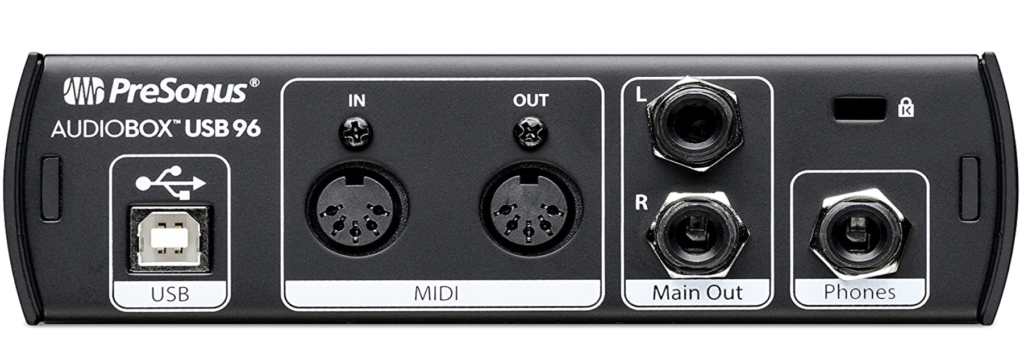
On the back panel is a USB-B port. And two MIDI Ports: MIDI In & MIDI Out for connecting MIDI controllers and synths.
You’ll also find two balanced ¼-inch outputs. And a ¼ inch headphone output.
Sound Quality & Specs
Recording Quality
The USB 96 can record up to 96kHz at 24-bits – the standard audio resolution for professional recording.
These days, most people record at 44.1 and 48kHz, but 96kHz playback is great for post-production.
Mic Inputs and Preamps
You’ll also get a couple of quality mic inputs for condenser mics.
The USB 96 has a relatively flat frequency response at moderate gain levels.
However, its frequency response and preamp noise aren’t ideal at higher gain levels.
As a side note, frequency response measures accurately; an analog-to-digital can capture different frequencies in your audio.
In addition, preamp noise is the slight hiss you hear in your audio.
Ideally, we want it to be unnoticeable.
The USB 96 and Dynamic Mics
Since the USB 96 underperforms at higher gain levels, it’s not the best option for low-signal dynamic mics.
Dynamic mics like the Shure SM7B require more gain than condenser mics to reach the proper recording level.
The USB 96 and Condenser Mics
For condenser mics, the USB 96 offers excellent preamps for its price.
From our experience, you’ll get clear and transparent recordings for audio and music production.
Compatibility
The AudioBox 96 is compatible with almost all macOS and Windows recording software.
For window users, install the driver found on PreSonus’ website before using this interface.
Software Bundle
The USB 96 comes with access to Studio One Artist, a beginner-friendly digital audio workstation (DAW) compatible with Windows and Mac.
While Studio One Artist is limited, it provides all the basic audio and music production tools.
It also comes with the Studio Magic Plug-In Suite, including six virtual instruments and nine effects plugins.
Reviews
The AudioBox 96 is a great option for basic home recording.
It continues to be a popular choice for beginners and pros looking for a quality, affordable interface.
Why?
People like USB 96 for its simple design and reliable sound quality.
Specifically, many reviewers agree that its preamps sound relatively clear and transparent – especially for an interface under $100.
Many people also comment on how easy Studio One Artist is to use for beginners.
Personally, our favorite feature is the mixer control because of the flexibility added flexibility it provides when recording.
PreSonus Studio 24c

The Studio 24c has received many positive reviews. It has a durable, travel-friendly design and delivers excellent recording quality.
PreSonus Studio vs Presonus AudioBox
The Presonus Studio 24C is a more modern version of the AudioBox 96 with improved sound quality.
It sets itself apart from the AudioBox with its modern design, highly rated XMAX-L mic preamps, and LED I/O level meters.
Pros
Cons
- Housed in heavy-duty steel
- Lightweight / portable
- Mixer knob for zero-latency monitoring
- High-quality XMAX-L mic preamps
- Small control knobs that are positioned close together.
- Headphone output on the back
Features
- 2 combo inputs (XLR mic, ¼ inch instrument, & ¼ inch line)
- 2 Class-A XMAX-L mic preamps with up to 50dB of gain
- MIDI I/O
- Mixer Control for direct monitoring
- +48V phantom power for condenser mics
- Studio One Artist & Ableton Live Lite
- A/D Resolution: 24-bit; 192 kHz sampling rate
- Connectivity: USB-C
- LED monitoring panel
Design
This interface is compact with a quality build. It has a modern and intuitive design and features everything you need for high-quality audio recording.
Front Panel
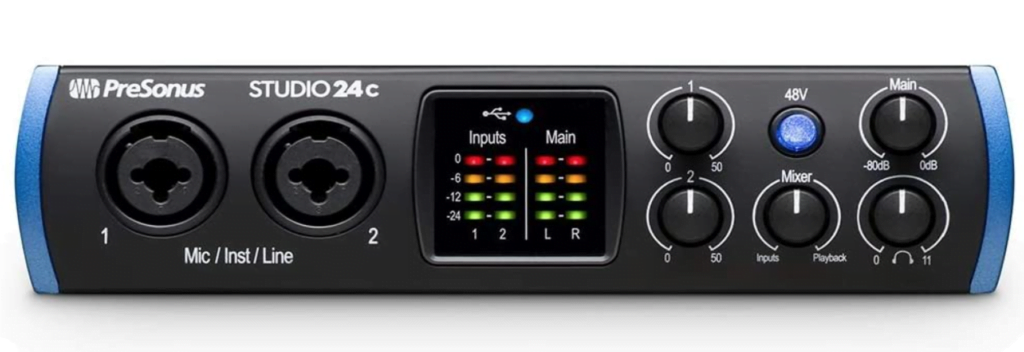
Unlike the AudioBox models, the front panel of Presonus Studio 24C includes four LED meters for tracking levels for each input and the main output.
These meters help you set gain levels and monitor clipping on each channel.
With the 24c, you’ll get two combo mic/line/instrument level inputs. And two gain knobs supplying each channel with up to 50 dB of gain.
Next to these knobs is a switch for enabling +48V phantom power, a mixer knob for zero-latency monitoring, and separate volume knobs for the headphone and main output.
Back Panel

On the back of the Studio 24c, you’ll find a USB-C port, MIDI I/O, two balanced main outs, and a headphone out.
Sound Quality & Specs
The Studio 24C features two inputs with XMAX-L solid-state low noise mic preamps that deliver more headroom, deeper lows, smoother highs, and a richer overall tone.
It can record up to 192kHz at 24-bits while the USB 96 maxes out at 96kHz.
The 24c also has quieter preamps and works better with dynamic mics.
Reviews
The Studio 24c is highly regarded for its professional quality XMAX-L mic preamps – known to produce a very clean and sharp sound.
Many people rave about how warm and clear their recordings sound when using this interface.
Its preamps also provide plenty of headroom for recording instruments like an electric guitar.
Lastly, many reviewers agree that the included software bundle adds additional value for those looking for an all-in-one recording solution.
Focusrite
Focusrite Scarlett 2i2
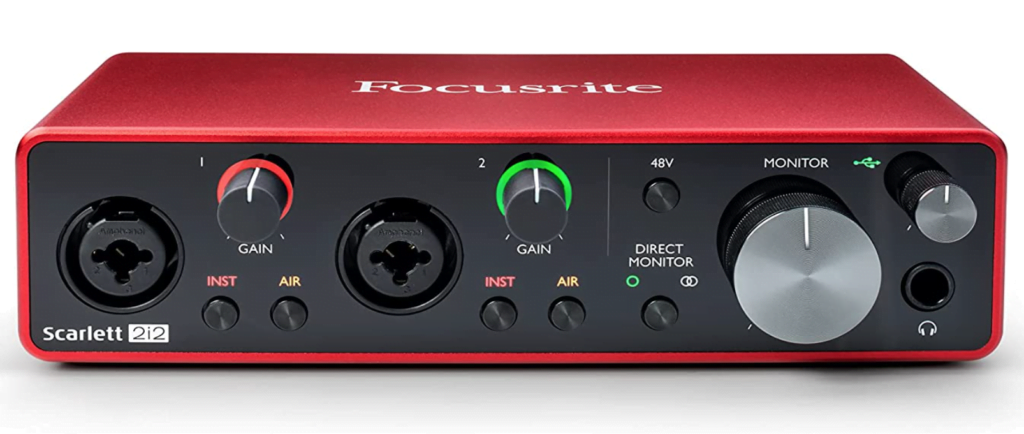
The Focusrite Scarlett 2i2 is one of the most popular audio interfaces for home audio and music production.
You’ll see it mentioned in almost every best audio interface list.
It has a clean, easy to navigating design and features that’ll enhance the quality of your home recordings – such as high-quality preamps, Air Mode, direct monitoring & more.
Pros
- Easy to operate
- Latency-free monitoring
- Large volume control knob
- Air Mode to emphasize higher frequencies
Cons
- Hard to match the gain level for dual inputs
Features
- 2 combo inputs (XLR mic, ¼ inch instrument, & ¼ inch line)
- Quality mic preamps providing up to 50dB of gain
- Gain Halos – LED rings around gain knobs for monitoring recording levels
- 48V+ phantom power for condenser mics
- Pro Tools First & Ableton Live Lite
- Hitmaker Expansion – Antares Auto Tune, Relab’s LX480 Essentials, XLN Audio’s Addictive Keys & more
- Three-month Avid Pro Tools subscription
- Three-month splice sounds subscription
- A/D Resolution: 24-bit; 44.1, 48, 88.1, 96, 176.4, and 192 kHz sampling rates
- Connectivity: USB-C
Design
Inputs and Preamps

The 2i2’s front panel has an intuitive design, making it easy to adjust settings during recording.
It features two combo XLR/ ¼ inch inputs.
The XLR input is for a mic-level signal, while you can use the ¼ inch inputs for an instrument or a line-level signal.
Next to each input, you’ll find a gain knob that boosts signals up to 46dB.
Conveniently, each gain knob has a halo LED meter that flashes red when your audio is clipping.
Instrument and Air Mode Buttons
Below each gain knob are two buttons; Inst and Air.
The Inst button lets you switch each ¼ input between line and instrument levels.
On the other hand, the “Air” button activates Air Mode.
Other Controls
On the right two buttons for toggling +48V phantom power and direct monitoring in mono or stereo.
You’ll also find a large main output volume knob, headphone output, and headphone volume control.
Overall, the 2i2 features large spaced-out knobs that are easy to navigate and adjust during recording.
Back Panel
On the back of the 2i2 are a USB-C port and two balanced line outputs.
Sound Quality & Specs
The 2i2 comes with two high impedance and high headroom inputs, making it great for recording vocals and instruments without clipping or distortion.
In terms of dynamic range, the 2i2 comes in at around 110 dB(A).
Dynamic range is the difference between the loudest and quietest signal your interface can record.
Ultimately, a higher dynamic range gives you more headroom while recording.
You’ll also get a couple of clear and transparent preamps with an ultra-low equivalent input noise of around -128 dB(A).
Lastly, the 2i2 features Air Mode, which lets you add color to your audio without using an external preamp.
With Air Mode activated, your audio will sound brighter and more open.
Software and Compatibility
The Scarlett 2i2 is compatible with Windows 7 or macOS 10.11 and higher and iPad Pro.
The 2i2 comes with a host of free software.
You’ll get access to…
- Pro Tools First and Ableton Live Lite – giving you the essential tools you need to get started recording and producing.
- The Hitmaker Expansion, which features plug-ins and VSTs to help you record, produce, mix, and master high-quality music – plug-ins include Antares Auto-Tune, four reverbs for vocals from Relab’s LX480, and Softube’s Silver Jubilee 2555, an amp simulator.
- Four professional-sounding piano models from XLN Audio Addictive Keys and various drum sounds from XLN’s Addictive Drums Studio Rock Kit.
- Access to quality EQs, compressors, mastering tools, and more.
Reviews
The Focusrite Scarlett 2i2 is one of the most popular audio interfaces.
What people like the most about this interface is its design – many reviews appreciate how easy it is to navigate without having to overthink.
Each knob and button has its own section and LED indicators – making them easy to identify.
Overall, the 2i2’s user-friendly design and excellent recording quality make it one of the most sought-after entry-level interfaces.
PreSonus vs Focusrite: Which is Better?
Design Comparison
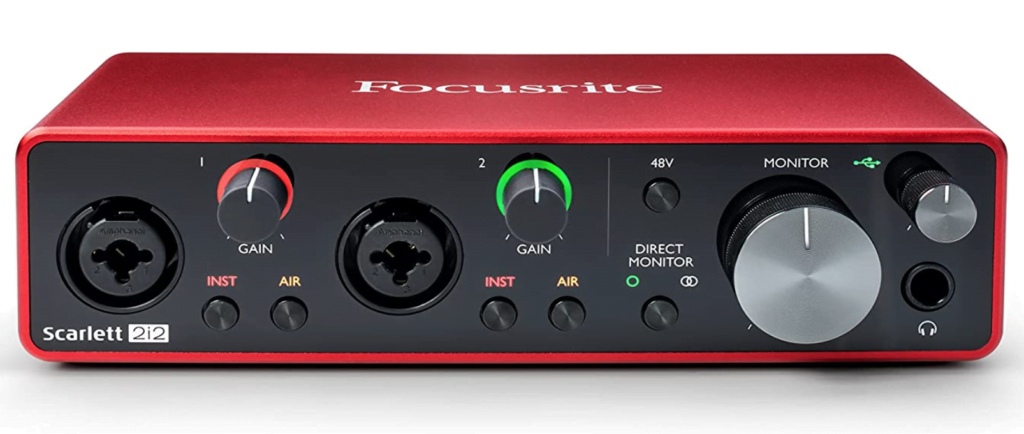
Winner = Focusrite Scarlett
- Durable / travel-ready – encased in heavy-duty steel
- User-friendly design – easy to use
Build Quality
Winner = Tie
Both PreSonus and Focusrite build interfaces with high-quality material.
We can’t give either unit the edge in this category.
Layout
Winner = Focusrite Scarlett
A part of what makes the Scarlett 2i2 popular is its user-friendly design.
Its clean design makes it super easy to navigate, especially for beginners.
On the other hand, a common criticism of the AudioBox and Studio models is their knobs feel crammed.
Since their knobs are so close together, adjusting levels can be more difficult.
The 2i2 also has a simpler layout.
Unlike the USB 96 and 24c, the 2i2, each gain knob is directly next to its input and has a large output volume knob.
While these differences can seem minor, they can help you decide between different options.
Features Comparison
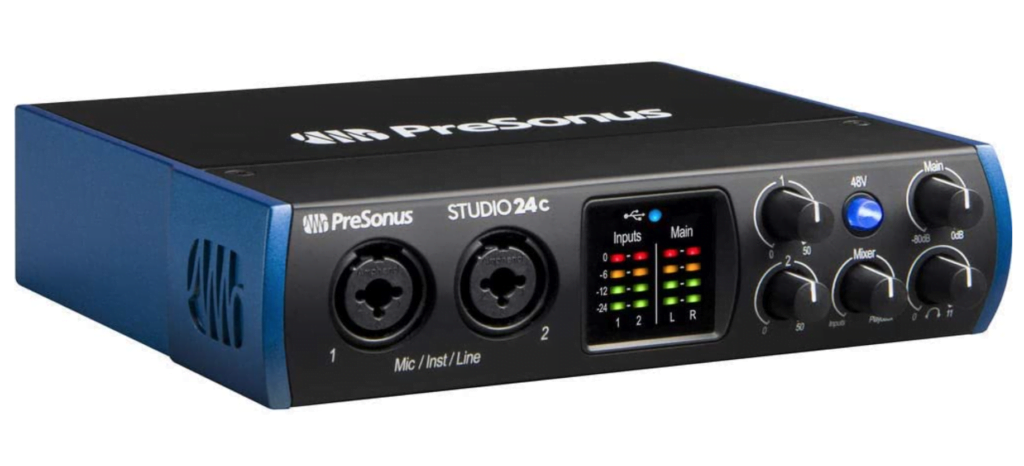
Winner: PreSonus
- The Studio 24c features professional quality XMAX-L preamps
- Mixer control function
- MIDI compatibility
Preamps
Winner = PreSonus Studio
All three models feature quality preamps, but we have to give the edge to the Studio 24c’s XMAX-L preamps.
They’re known to deliver crystal-clear audio with deeper lows, smoother highs, and a richer tone.
Monitoring & Recording
Winner = Tie
Which audio interface is better for monitoring and recording?
We believe it’s a tie.
All PreSonus and Focusrite interfaces have great features for home recording.
PreSonus’ mixer control function lets you blend your direct signal – for zero-latency recording – and the playback from your DAW.
We prefer a mixer knob for direct monitoring over an on/off switch.
But with the 2i2, you can enable direct monitoring for mono and stereo recording.
MIDI Compatibility
Winner = PreSonus
Unlike Focusrite Scarlett, the Studio and AudioBox models have MIDI I/O for connecting MIDI devices.
MIDI connection won’t be a game-changer for most people since most MIDI devices connect via USB.
However, if you’re looking for an all-in-one unit, PreSonus is the way to go.
Additional Features
Winner = Focusrite Scarlett
An added bonus to the Focusrite Scarlett is its air mode feature which imitates the Air Effect in Focusrite’s original ISA mic preamp.
When activated, it makes your audio sound more open.
Takeaway: Presonus vs Focusrite – Which is Better?
When comparing Focusrite and PreSonus’s most popular interfaces, we give the slight edge to Scarlett 2i2 over the AudioBox 96 and Studio 24c.
All of these models are excellent choices for home production.
But the 2i2’s easy-to-use design and additional features like Air Mode make it the better choice overall.
- Initiative design – easy to use while recording
- Big knobs – easy to find and adjust quickly
- Quality preamps
- Air Mode








